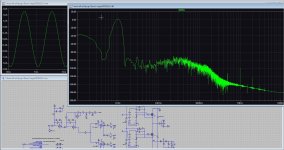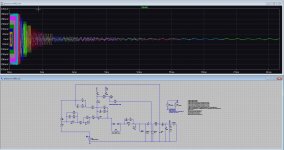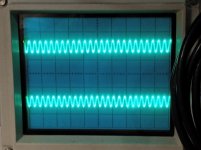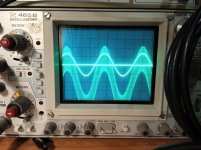Are there false modules then? Little difficult to copy as it looks to me.
I have however a real one, it is from a subwoofer, did get if from someone who did has a new one and trow this away.
The feedback system is mECC but for me it is just a double opamp PID system. Looks like the most feedback systems around.
Much feedback will not make sound better. GAN mosfets are however promissing, need just small feedback or even none..
Mecc looks like this, however this is a flying cap three level. (see pic)
I have however a real one, it is from a subwoofer, did get if from someone who did has a new one and trow this away.
The feedback system is mECC but for me it is just a double opamp PID system. Looks like the most feedback systems around.
Much feedback will not make sound better. GAN mosfets are however promissing, need just small feedback or even none..
Mecc looks like this, however this is a flying cap three level. (see pic)
Attachments
According to my sources almost every ICEPower amp that is ordered from China is fake and it is almost impossible to tell them apart except that the fakes have a very high failure rate. I would say that from time to time Ghent Audio sell excess stock of ICEPOwer amps and as far as I know, they are real ICEPower amps.Are there false modules then? Little difficult to copy as it looks to me.
I have however a real one, it is from a subwoofer, did get if from someone who did has a new one and trow this away.
The feedback system is mECC but for me it is just a double opamp PID system. Looks like the most feedback systems around.
Much feedback will not make sound better. GAN mosfets are however promissing, need just small feedback or even none..
Mecc looks like this, however this is a flying cap three level. (see pic)
I have one who is coming from a subwoofer who is buyed in the netherlands, I have however a fault in it that is does not work
except the supply who is fine. This is not a fake amp. I hav however ic,s in like the mosfet driver I can not tell what types that is, the opamps are in one chip
who also have only a icepower type.
I have not yet try to repair, to busy with other things.
I have made a kind of drawn what the icepower does, it is not a super feedback system, do not exist just , it is made also by other vendors.
It is by the way no PID but PI.
except the supply who is fine. This is not a fake amp. I hav however ic,s in like the mosfet driver I can not tell what types that is, the opamps are in one chip
who also have only a icepower type.
I have not yet try to repair, to busy with other things.
I have made a kind of drawn what the icepower does, it is not a super feedback system, do not exist just , it is made also by other vendors.
It is by the way no PID but PI.
Attachments
Well, as I have promised, I have ventured into replacing the faulty L100.
To do it, I have removed P102 connector first in order to gain access to L100. Desoldering it was a breeze with hot air SMD workstation, but putting new component ... well, to cut long story short, after second try, I have finally managed to put it in place. For me, soldering iron with good and clean tip and fine pair of tweezers have done the trick.
It turned out that, whille my measuring attempt in which I have rendered L100 useless, I have also managed to destroy track for channel 1 input signal, going from L100 to first resistor. I have tried to correct that by using more solder and thus connecting those two together.
Next, I need to check other components to see what else have I damaged.
Here is the picture of L100 prepared for desoldering.
Finally, I am more than happy to share a link to the component I have decided to replace faulty L100 with, in case that is ok with forum rules. If not, you can always PM me.
To do it, I have removed P102 connector first in order to gain access to L100. Desoldering it was a breeze with hot air SMD workstation, but putting new component ... well, to cut long story short, after second try, I have finally managed to put it in place. For me, soldering iron with good and clean tip and fine pair of tweezers have done the trick.
It turned out that, whille my measuring attempt in which I have rendered L100 useless, I have also managed to destroy track for channel 1 input signal, going from L100 to first resistor. I have tried to correct that by using more solder and thus connecting those two together.
Next, I need to check other components to see what else have I damaged.
Here is the picture of L100 prepared for desoldering.
Finally, I am more than happy to share a link to the component I have decided to replace faulty L100 with, in case that is ok with forum rules. If not, you can always PM me.
Attachments
This is said because the original ones also seem to fail a lot. They come from China like everything comes from China. It is a cover up for the high failure rate. Many think in emotions and a favorite A Brand class D module going kaputt does not fit.According to my sources almost every ICEPower amp that is ordered from China is fake and it is almost impossible to tell them apart except that the fakes have a very high failure rate.
Proof is original A brands that definitely have original B&O modules and their failure rate.
Last edited:
Does anyone know is it normal to have a signal of 1.6Vpp @ 100kHz after LC filter, when there is no input signal?
Here you can see the oscilograms of both channels, as well as an example of output signal on the speaker.
To be honest, I am not comfortable with this signal, so if someone have more experience, I would be very grateful.
Kind regards.
B
Just to be sure, module seems to be working, apart from this residual signal.
Here you can see the oscilograms of both channels, as well as an example of output signal on the speaker.
To be honest, I am not comfortable with this signal, so if someone have more experience, I would be very grateful.
Kind regards.
B
Just to be sure, module seems to be working, apart from this residual signal.
Attachments
Last edited:
No is not normal, the frequency is to low, this modules run on 500 Khz if I remember, that means that in that case the leak of hf is a lot lower. Maybe there is a defect in it. I do not now if this modules are three level version, than signal is doubled normally.
What is that with these supressor coil? I read a lot of problems with it, maybe because of temperature it breaks because it is soldered as a smd? Little room to expand, and do crack in time.Well, today I have finally tesred module with new L100.
For the time being, it looks that it is working well.
Here are some pictures - with new L100 and assembled and tested.
Hi everyone,Are you sure that the modules are genuine ICEPower modules? Agedhorse on both the US Talkbass And UK Basschat forums has said that there are many fake ICEPower moduLes from China and the often go faulty. In addition,this module has to be fan cooled to get full power. Mine is not, but the only thing that happens is a short time shut down, 2-3 seconds.
I have three of the SE modules but they areare not with me at the moment. I will try to check a good one to measure the component.
One final comment. Put a real replaceable fuse on the two auxiliary power lines. They are easier to replace than the onboard fuses in case of a short.
I know this is an old thread, but I was wondering if anyone ever discovered the value of C201 which has also burnt/blown on my module.
The capacitor on the underside is still intact. Is it possible to determined the value of this capacitor (which I'm guessing would be the same value?) with a multimeter?
Many thanks
I think that is then not done with permission of B and O because it is only legal when produced in license environment. So these are real fake, European Union is already start a investigation about the many fake products who are in there eyes dangerous for the people also.According to my sources almost every ICEPower amp that is ordered from China is fake and it is almost impossible to tell them apart except that the fakes have a very high failure rate. I would say that from time to time Ghent Audio sell excess stock of ICEPOwer amps and as far as I know, they are real ICEPower amps.
I have no reason to believe that the one I have is a "fake". Its original to a TEAC A-H01 DAC with built-in amplifier that I have owned from new. So unless TEAC were putting fake modules into their devices I very much doubt it is a fake.
All I need to know is whether anyone has determined the value of C201, which has blown on my module.
All I need to know is whether anyone has determined the value of C201, which has blown on my module.
I have a module somewhere, around that cap is also a smd coil, as I did read
somewhere this do break.
I can look at it tomorrow to see what cap it is.
somewhere this do break.
I can look at it tomorrow to see what cap it is.
Agree with Jean-paul...These modules are unreliable!This is said because the original ones also seem to fail a lot.
I had a 125asx...
Loss of sound...and too annoying to repair...Too expensive...
The tpa and MA chips are much more reliable!
Perhaps they are unreliable. Although saying that mine has been running flawlessly without fault until recently when it blew C201 and now has no sound. I have inspected the board, and it appears only C201 has failed, the rest of the board looks fine so far. So, for the sake of trying to replace C201 with the correct value, it may well resolve the issue. My only problem is that the original SMD Capacitor is completely gone, and the one on the underside is not printed with any values.
I would at least like to try replacing C201 before scrapping it completely. At this point I have nothing to lose.
I would at least like to try replacing C201 before scrapping it completely. At this point I have nothing to lose.
These are capacitors for filtering I guess, like 10 nF, the blown ones is because of over voltage grid, if supply do still work it is just replace with one 10nF or 100nF, need 400 volts or so, strange such a small smd can withstand this. caps do work together with emi filter. A fly back supply like here is used are not that safe for audio amps, because with over voltages these can get give over voltage when stressed, resonance is the good way here.Dear herve34, my guess is that this component is a simple capacitor going from one AC leg of bridge rectifier to the ground. As far as I can see it, there are two of them. One is near the bridge rectifier and that is the one burned from your picture, and the other one is on the other side of board, where you can clearly see that is connected between one AC input and ground.
https://electronics.stackexchange.c...-extra-capacitors-around-the-bridge-rectifier
Now, the question one should ask is why they have burned on two different boards? Voltage too high?
- Home
- Amplifiers
- Class D
- ICEpower 50ASX2 BTL




![20220720_204959[1].jpg](/community/data/attachments/981/981880-03c32e225252b7c6cf517eefb9b1092a.jpg?hash=A8MuIlJSt8)



